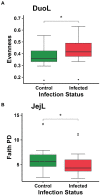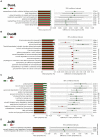Effects of Eimeria acervulina infection on the luminal and mucosal microbiota of the duodenum and jejunum in broiler chickens
- PMID: 37020716
- PMCID: PMC10067739
- DOI: 10.3389/fmicb.2023.1147579
Effects of Eimeria acervulina infection on the luminal and mucosal microbiota of the duodenum and jejunum in broiler chickens
Abstract
The intestinal disease coccidiosis, caused by Eimeria parasites, impacts nutrient absorption in broiler chickens, leading to weight gain depression and major losses in the poultry industry. To develop alternatives to antibiotics for treating infected chickens, the gut microbiota has been researched because of its association with health factors such as nutrient exchange, immune system modulation, digestive system physiology, and pathogen exclusion. The aim of this study was to determine the effect of Eimeria acervulina infection on the luminal and mucosal microbiota of both the duodenum (DuoL and DuoM) and jejunum (JejL and JejM) at multiple time points (days 3, 5, 7, 10, and 14) post-infection. 16S rRNA amplicon sequencing was utilized to characterize the microbiota and analyze differences in alpha and beta diversity between infected (IF) and control (C) birds at each time point. Alpha diversity differed between IF and C birds in DuoM and JejM microbiota. Combined with beta diversity results, DuoM microbiota appeared to be affected by infection in the longer-term, while JejM microbiota were affected in the shorter-term. Relative abundances of bacterial taxa known for short-chain fatty acid (SCFA) production, such as Lachnospiraceae, Subdoligranulum, and Peptostreptococcaceae, tended to be lower in IF birds for all four microbiota. Moreover, predicted functional abundances showed MetaCyc pathways related to SCFA production, especially butyrate, may be influenced by these differences in bacterial relative abundance. Our findings expand understanding of how Eimeria infection affects luminal and mucosal microbiota in the duodenum and jejunum, and further research on metagenomic function may provide insights on the degree of influence duodenal and jejunal bacteria have on chicken health.
Keywords: 16S; Coccidiosis; broiler chickens; duodenum; jejunum; microbiota.
Copyright © 2023 Campos, Miska, Jenkins, Yan and Proszkowiec-Weglarz.
Conflict of interest statement
The authors declare that the research was conducted in the absence of any commercial or financial relationships that could be construed as a potential conflict of interest. The handling editor MK declared a shared affiliation with the authors at the time of review.
Figures






Similar articles
-
Temporal changes in cecal luminal and mucosal microbiota of broiler chickens with clinical coccidiosis (Eimeria maxima).PLoS One. 2025 Apr 24;20(4):e0321212. doi: 10.1371/journal.pone.0321212. eCollection 2025. PLoS One. 2025. PMID: 40273096 Free PMC article.
-
Temporal Changes in Jejunal and Ileal Microbiota of Broiler Chickens with Clinical Coccidiosis (Eimeria maxima).Animals (Basel). 2024 Oct 15;14(20):2976. doi: 10.3390/ani14202976. Animals (Basel). 2024. PMID: 39457906 Free PMC article.
-
Effects of Eimeria acervulina infection on the luminal and mucosal microbiota of the cecum and ileum in broiler chickens.Sci Rep. 2024 May 10;14(1):10702. doi: 10.1038/s41598-024-61299-6. Sci Rep. 2024. PMID: 38729976 Free PMC article.
-
Effects of Eimeria tenella on Cecal Luminal and Mucosal Microbiota in Broiler Chickens.Avian Dis. 2022 Mar;66(1):39-52. doi: 10.1637/21-00068. Epub 2022 Jan 10. Avian Dis. 2022. PMID: 35191646
-
Understanding the interactions between Eimeria infection and gut microbiota, towards the control of chicken coccidiosis: a review.Parasite. 2021;28:48. doi: 10.1051/parasite/2021047. Epub 2021 Jun 2. Parasite. 2021. PMID: 34076575 Free PMC article. Review.
Cited by
-
Dynamic response of the intestinal microbiome to Eimeria maxima-induced coccidiosis in chickens.Microbiol Spectr. 2024 Oct 3;12(10):e0082324. doi: 10.1128/spectrum.00823-24. Epub 2024 Sep 9. Microbiol Spectr. 2024. PMID: 39248475 Free PMC article.
-
Large-Scale Field Trials of an Eimeria Vaccine Induce Positive Effects on the Production Index of Broilers.Vaccines (Basel). 2024 Jul 19;12(7):800. doi: 10.3390/vaccines12070800. Vaccines (Basel). 2024. PMID: 39066438 Free PMC article.
-
Temporal changes in cecal luminal and mucosal microbiota of broiler chickens with clinical coccidiosis (Eimeria maxima).PLoS One. 2025 Apr 24;20(4):e0321212. doi: 10.1371/journal.pone.0321212. eCollection 2025. PLoS One. 2025. PMID: 40273096 Free PMC article.
-
Broiler chicken distal jejunum microbial communities are more responsive to coccidiosis or necrotic enteritis challenge than dietary anti-interleukin-10 in a model using Salmonella Typhimurium- Eimeria maxima- Clostridium perfringens coinfection.Poult Sci. 2024 Sep;103(9):104000. doi: 10.1016/j.psj.2024.104000. Epub 2024 Jun 22. Poult Sci. 2024. PMID: 39002369 Free PMC article.
-
Temporal Changes in Jejunal and Ileal Microbiota of Broiler Chickens with Clinical Coccidiosis (Eimeria maxima).Animals (Basel). 2024 Oct 15;14(20):2976. doi: 10.3390/ani14202976. Animals (Basel). 2024. PMID: 39457906 Free PMC article.
References
LinkOut - more resources
Full Text Sources
Miscellaneous

